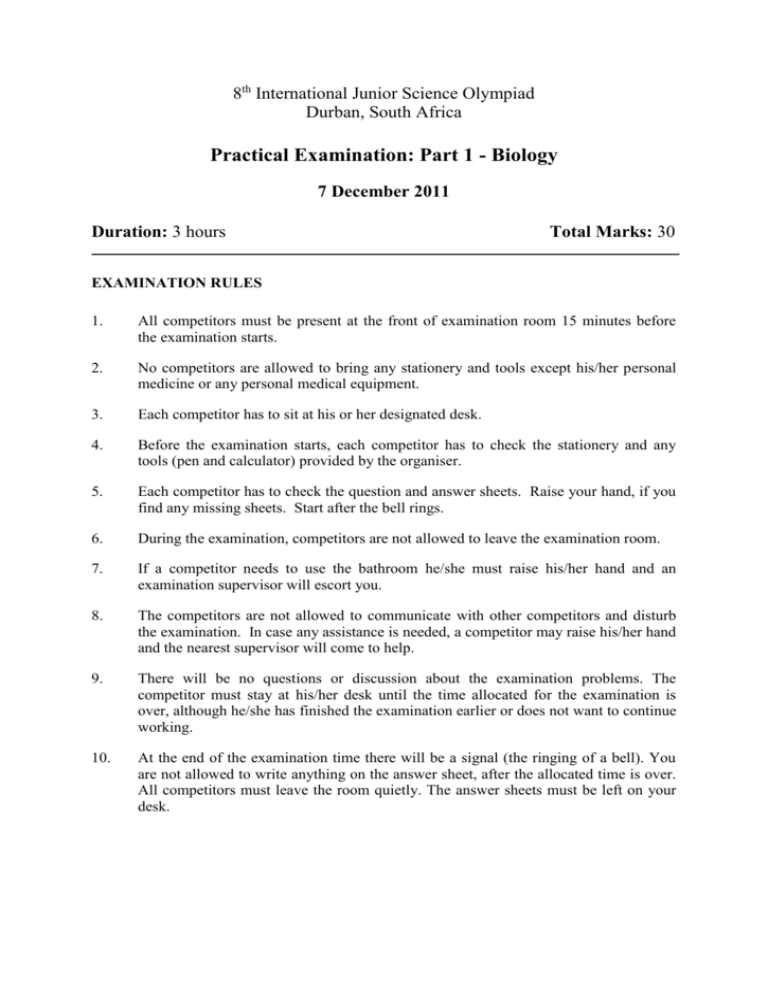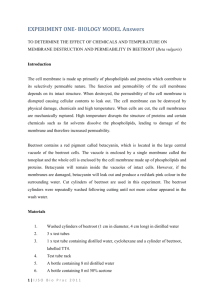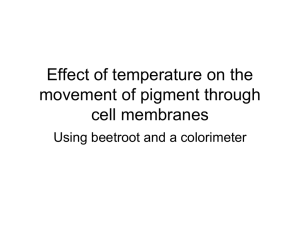Biology practical question paper.doc
advertisement

8th International Junior Science Olympiad Durban, South Africa Practical Examination: Part 1 - Biology 7 December 2011 Duration: 3 hours Total Marks: 30 EXAMINATION RULES 1. All competitors must be present at the front of examination room 15 minutes before the examination starts. 2. No competitors are allowed to bring any stationery and tools except his/her personal medicine or any personal medical equipment. 3. Each competitor has to sit at his or her designated desk. 4. Before the examination starts, each competitor has to check the stationery and any tools (pen and calculator) provided by the organiser. 5. Each competitor has to check the question and answer sheets. Raise your hand, if you find any missing sheets. Start after the bell rings. 6. During the examination, competitors are not allowed to leave the examination room. 7. If a competitor needs to use the bathroom he/she must raise his/her hand and an examination supervisor will escort you. 8. The competitors are not allowed to communicate with other competitors and disturb the examination. In case any assistance is needed, a competitor may raise his/her hand and the nearest supervisor will come to help. 9. There will be no questions or discussion about the examination problems. The competitor must stay at his/her desk until the time allocated for the examination is over, although he/she has finished the examination earlier or does not want to continue working. 10. At the end of the examination time there will be a signal (the ringing of a bell). You are not allowed to write anything on the answer sheet, after the allocated time is over. All competitors must leave the room quietly. The answer sheets must be left on your desk. 8th International Junior Science Olympiad Durban, South Africa Practical Examination: 7 December 2011 Part 1: Biology Page 2 TO DETERMINE THE EFFECT OF CHEMICALS AND TEMPERATURE ON MEMBRANE DESTRUCTION AND PERMEABILITY IN BEETROOT (Beta vulgaris) Introduction The cell membrane is made up primarily of phospholipids and proteins which contribute to its selectively permeable nature. The function and permeability of the cell membrane depends on its intact structure. When destroyed, the permeability of the cell membrane is disrupted causing cellular contents to leak out. The cell membrane can be destroyed by physical damage, chemicals and high temperature. When cells are cut, the cell membranes are mechanically ruptured. High temperature disrupts the structure of proteins and certain chemicals such as fat solvents dissolve the phospholipids, leading to damage of the membrane and therefore increased permeability. Beetroot contains a red pigment called betacyanin, which is located in the large central vacuole of the beetroot cells. The vacuole is enclosed by a single membrane called the tonoplast and the whole cell is enclosed by the cell membrane made up of phospholipids and proteins. Betacyanin will remain inside the vacuoles of intact cells. However, if the membranes are damaged, betacyanin will leak out and produce a red/dark pink colour in the surrounding water. Cut cylinders of beetroot are used in this experiment. The beetroot cylinders were repeatedly washed following cutting until not more colour appeared in the wash water. 8th International Junior Science Olympiad Durban, South Africa Practical Examination: 7 December 2011 Part 1: Biology Page 3 Materials 1. Washed cylinders of beetroot (1 cm in diameter, 4 cm long) in distilled water 2. 3 x test tubes labelled TT1, TT2 and TT3. 3. 1 x test tube containing distilled water, cyclohexane and a cylinder of beetroot labelled TT4. 4. Test tube rack 5. A bottle containing 8 ml distilled water 6. A bottle containing 8 ml 50% acetone 7. A bottle containing 8 ml 100% acetone 8. 1x sheet graph paper Experimental procedure 1. Prepare the 3 test tubes as follows (see Table 1): Pour the distilled water into TT1. Pour the 50% acetone into TT2. Pour the 100% acetone into TT3. 2. Place all tubes in the test tube rack. 3. Immediately place a washed cylinder of beetroot in TT1, TT2 and TT3. 4. Shake test tubes 1-4 gently for a few seconds. 5. After 15 minutes observe the colour of the solution in each test tube. Table 1: Solvents in Test Tubes 1-4 TEST TUBES SOLVENTS Test tube 1 Test tube 2 Test tube 3 Test tube 4 (TT1) (TT2) (TT3) (TT4) Distilled water 50% Acetone 100% Acetone Distilled water + Cyclohexane 8th International Junior Science Olympiad Durban, South Africa Practical Examination: 7 December 2011 Part 1: Biology Page 4 QUESTIONS SECTION 1 a. At the start of the experiment, the distilled water surrounding the washed cylinders of beetroot appeared clear in colour. Why? Choose the correct answer by ticking the appropriate box in the answer sheet. i. Betacyanin is not soluble in water. ii. Betacyanin is soluble in organic solvents only. iii. Damaged cells were empty of betacyanin after repeated washing, and no further cell membrane damage occurred. iv. All the above. (0.5 mark) b. Which test tube represents the control? Choose the correct answer by ticking the appropriate box in the answer sheet. TT1 TT2 TT3 TT4 (0.5 mark) c. Based on the colour of the solution in TT2 and TT3, where was betacyanin more soluble? Choose the correct answer by ticking the appropriate box in the answer sheet. 50% acetone 100% acetone (0.5 mark) 8th International Junior Science Olympiad Durban, South Africa Practical Examination: 7 December 2011 Part 1: Biology Page 5 d. In TT4 which layer represents water? Choose the correct answer by ticking the appropriate box in the answer sheet. Upper Lower (0.5 mark) e. Why was the water coloured in TT4 but NOT in TT1? Choose the correct answer by ticking the appropriate box in the answer sheet. i. The cell membranes in TT1 were not further disrupted. ii. Cyclohexane damaged the cell membranes in TT4, causing betacyanin to leak out. iii. Cyclohexane dissolved the lipids in the cell membranes in TT4, causing betacyanin to leak out, which dissolved in the water only. iv. All the above statements are correct. (0.5 mark) 8th International Junior Science Olympiad Durban, South Africa Practical Examination: 7 December 2011 Part 1: Biology Page 6 SECTION 2 f. An experiment to determine the effect of temperature on membrane structure and permeability in beetroot was conducted earlier this week. The washed cylinders of beetroot were placed in test tubes containing distilled water and then incubated at 20ºC, 30ºC, 40ºC, 60ºC and 80ºC for 15 minutes. Thereafter the absorbance of the solution in each test tube was recorded at a wavelength of 605 nm. Distilled water was used as the blank. The experiment was repeated three times and the data is shown in Table 2 below. The absorbance is a measure of the amount of light absorbed by the sample. The darker the sample the greater the absorbance. Based on the information given in this extract (f) and Table 2 below, complete the following tasks in the answer sheet. i. Complete Table 2 by calculating the mean absorbance at each temperature and record in the column provided. (0.25 x 4 = 1 mark) ii. Based on the mean absorbance values, at what temperature did the proteins in the membranes begin to denature? Write your answer in the box below. (0.5 mark) iii. Plot a graph on the graph paper provided using the mean absorbance to show the effect of temperature on membrane permeability in beetroot. (2.5 marks) 8th International Junior Science Olympiad Durban, South Africa Practical Examination: 7 December 2011 Part 1: Biology Page 7 Table 2: Effect of temperature on membrane permeability in beetroot Temperature (ºC) Absorbance Sample A Sample B Sample C 20 0.000 0.000 0.000 30 0.023 0.013 0.012 40 0.018 0.025 0.032 60 0.144 0.176 0.213 80 0.384 0.474 0.492 Mean SECTION 3 g. The mean absorbance readings of the solutions in TT2 and TT3 (in the first experiment in SECTION A) were 0.084 and 0.054 respectively. Indicate whether the following statements are true or false. Write T or F in the box provided. i. Betacyanin requires water for maximum solubility ii. Betacyanin is more soluble in 100% acetone than in 50% acetone (0.5 x 2 = 1 mark) h. From all the information gathered in these experiments on beetroot, in which solvent/s was betacyanin soluble? Choose the correct answer by ticking the appropriate box/es. Cyclohexane Water Hot water (0.5 mark) 8th International Junior Science Olympiad Durban, South Africa Practical Examination: 7 December 2011 Part 1: Biology Page 8 SECTION 4 i. The remaining washed cylinders of beetroot (approximately 50 cylinders) were placed in a glass jar containing 500 ml of 5 M sodium chloride (NaCl). Based on this information, indicate whether the following statements are true (T) or false (F) in the answer sheet. TRUE i. NaCl caused plasmolysis in the beetroot cells. ii. NaCl dissolved the lipids in the cell membranes. iii. The beetroot cells absorbed NaCl and became turgid. iv. The beetroot cells lost betacyanin to the surrounding water. FALSE (0.5 x 4 = 2 mark) TOTAL MARK (10)





